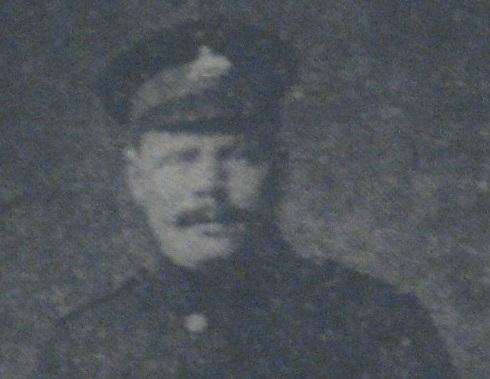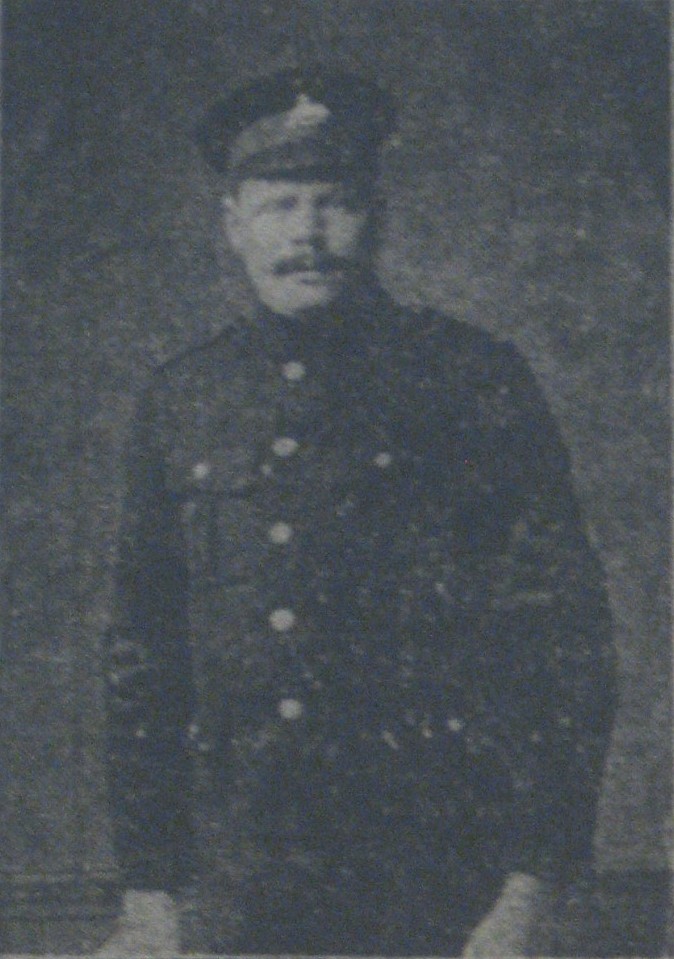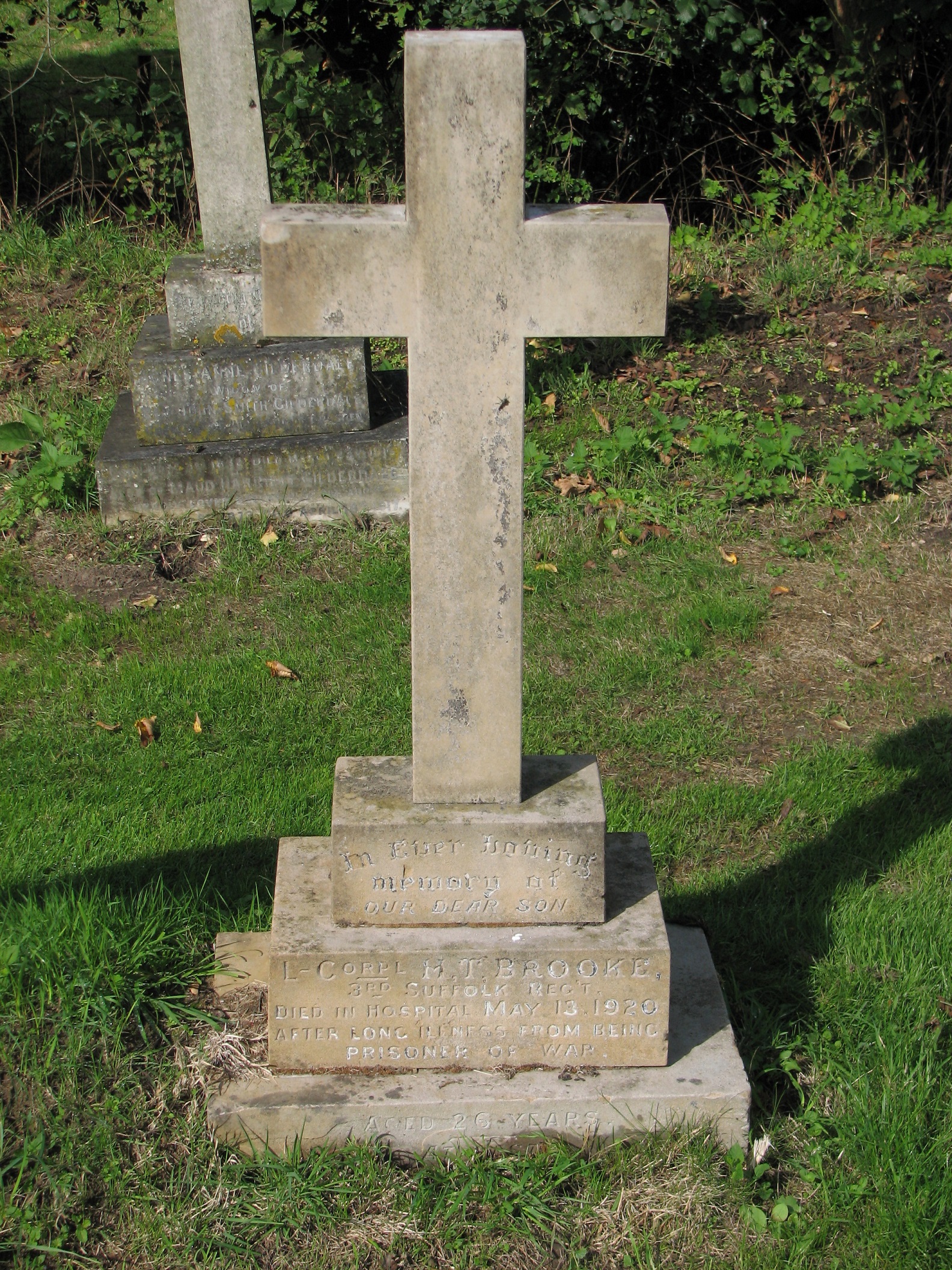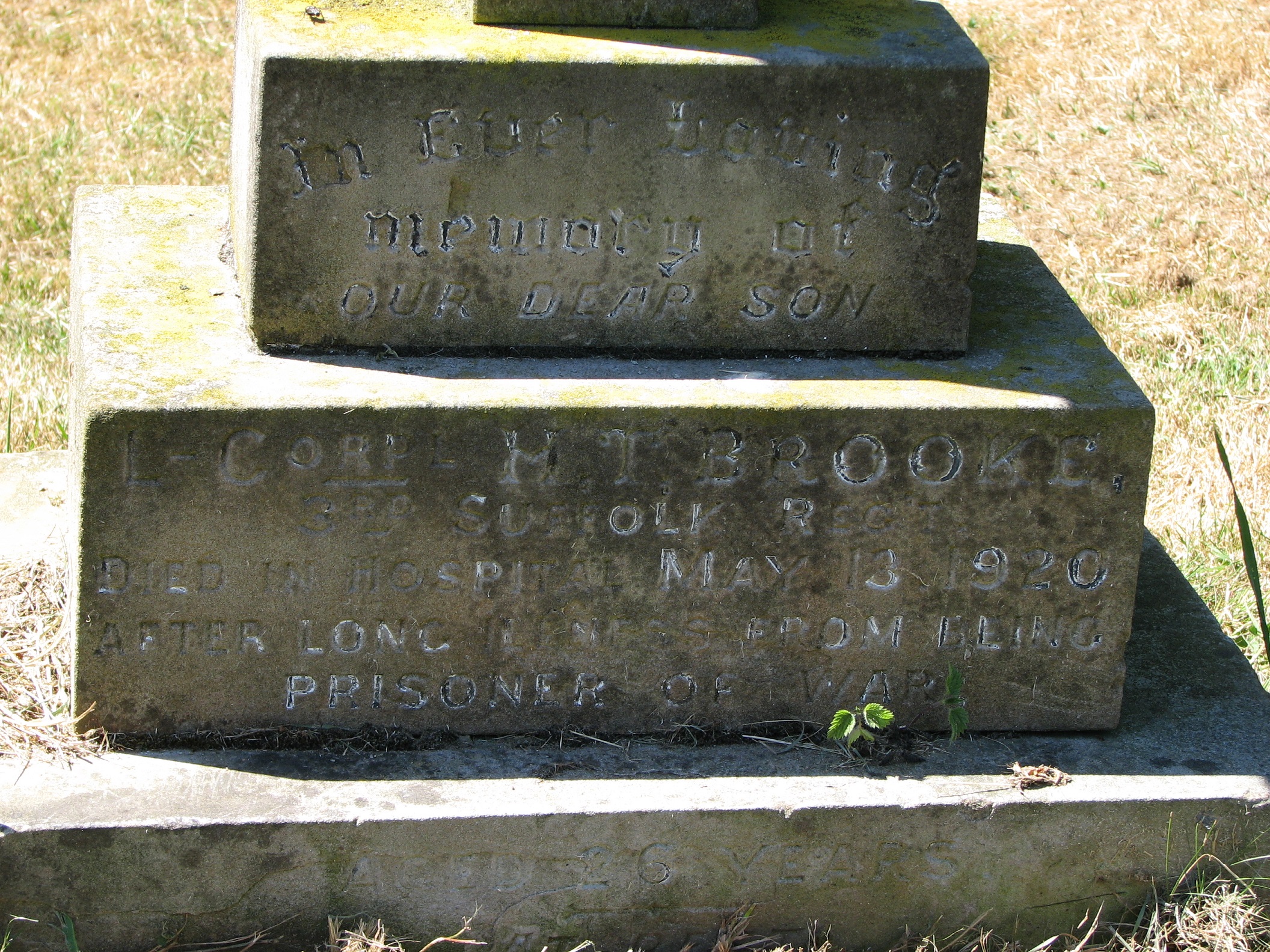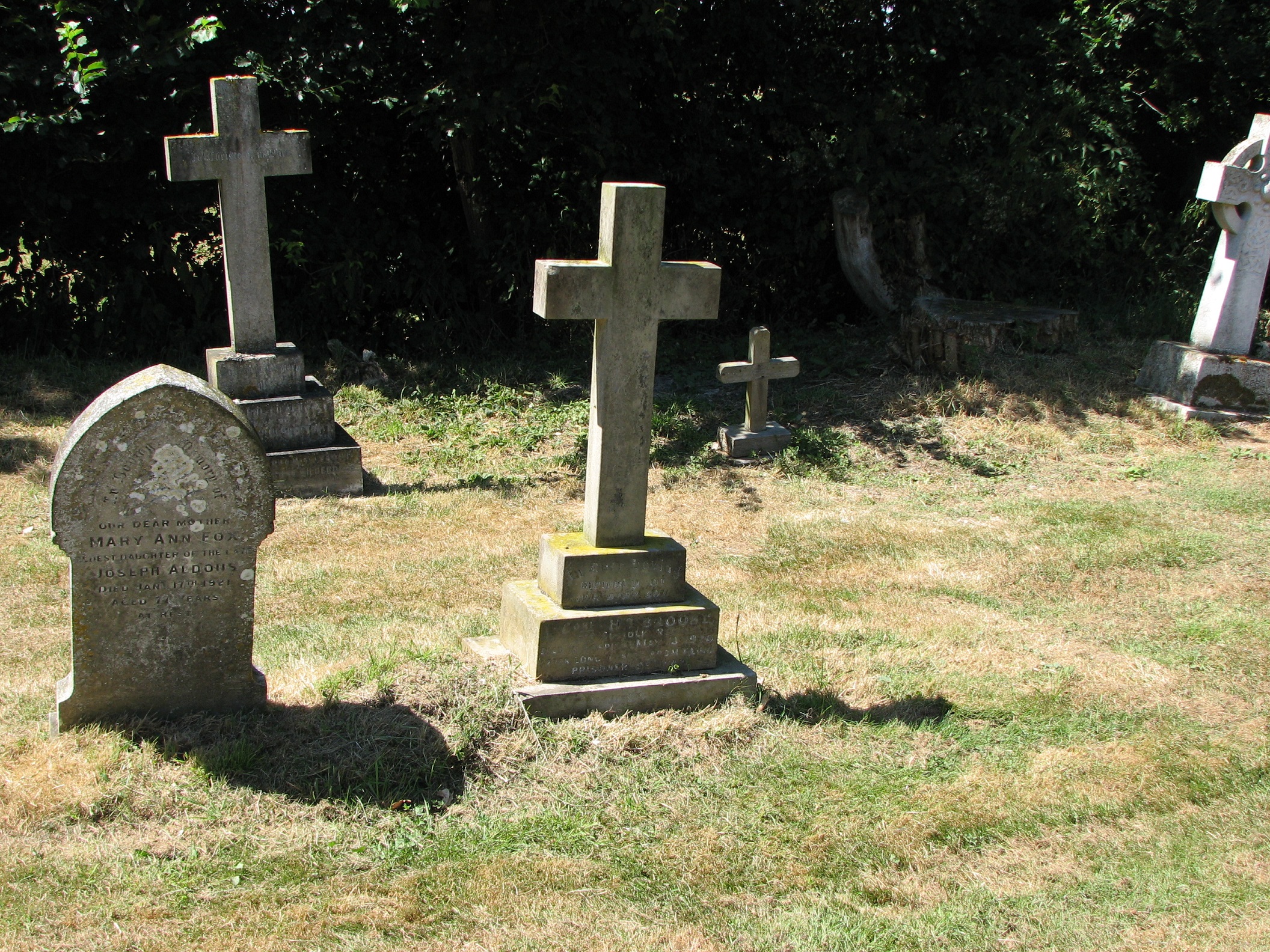Herbert Brooke (1894 - 1920)
Herbert served in France with the 4th Battalion of the Suffolk Regiment. He was captured by the Germans during the Battle of Arras in 1917 and died just over 3 years later, from ill health attributed to his time as a Prisoner of War in Germany. Herbert was buried with full military honours in East Bergholt Cemetery.
- 14
- Died in the Great War
- 51.968372, 1.031038
Details
| Name: | Herbert Thomas Brooke |
| Service: | British Army |
| Unit: |
4th Battalion, Suffolk Regiment 1 The Commonwealth War Graves Commission shows Herbert’s unit as the 2nd Battalion of the Suffolk Regiment. There is no other evidence to support this. He certainly never served with them overseas, and all the evidence indicates that this was a clerical error. |
| Regimental Number: | 202346 (previously 5538 and 24112) |
| Rank: | Lance Corporal |
| Date of Death: | 13th May 1920 |
| Age: | 26 |
| Buried: | East Bergholt Cemetery |
Family Background and Early Life
Herbert Brooke was born on 21st February 1894, at East Bergholt, the youngest of six children to Joseph and Alice Brooke (nee Finch).
Joseph Brooke was originally from Chelmondiston or Pin Mill, and at the time of Herbert’s birth he was working as a Labourer at a Saw Mill. Alice, who had been born at Manningtree, had married Joseph in 1877. Of their children, all lived to reach adulthood.
The Brooke family lived on what was initially called Manningtree Road, and later called White Horse Road.
Herbert started at East Bergholt School at Burnt Oak Corner on 6th June 1898, and left there the month after his fourteenth birthday. The April 1911 Census, shows the 17 year old Herbert as an Under Gardener – reflecting the standards of the time, when those learning a trade started off as trainees or apprentices. What Herbert did after that is not clear, but certainly by the autumn of 1915, he listed his occupation as General Labourer.
Volunteers to join the Army
Herbert volunteered for service in the British Army under the Group Scheme on 20th November 1915, and requested to serve in the Suffolk Regiment. 2 The Group Scheme was commonly called the Derby Scheme after Lord Derby, the Director-General of Recruiting. It was effectively a last ditch attempt by the government to increase recruitment by voluntary means, before they had to resort to conscription. He formally enlisted, but as permitted under the terms of the Scheme Herbert then chose to become part of the Army Reserve which meant he could go back to his civilian occupation until such time as he was required. He did not have long to wait, and was called up on 25th January 1916. 3 The report of Herbert’s Army Medical, conducted in November 1915, show that he was a tall man for his time: He was 6 foot and a quarter inch tall, and weighed 11 stone 7 lbs.
On 12th July 1916 Herbert was sent over to France, to join the British Expeditionary Force (B.E.F.). He was nominally posted to the Suffolk Regiment’s 7th Battalion, although he never actually joined them. Instead, like almost all soldiers arriving in France at this time, he initially spent a period at an Infantry Base Depot. 4 The Infantry Base Depots – normally situated close to the Channel coast – were effectively holding camps, where the soldiers were kept training whilst they awaited being posted to whichever unit required reinforcements.
Eight days after arriving in France, Herbert was posted to the 4th Battalion of the Suffolk Regiment, actually joining them on the 22nd of the month as part of a reinforcement draft of 283 men. The 4th was one of the Suffolk Regiment’s Territorial battalions, and had been in France since November 1914. 5 The Battalion had originally been made up of men of the Territorial Force, which was the forerunner of the modern Territorial Army. By the time that Herbert joined, many of the originals had become casualties and a large number of their replacements were wartime volunteers.
At the time that Herbert joined the 4th Suffolks, they were resting in billets, having just come out of the line from where they had been involved in some of the fighting during the opening weeks of the Battle of the Somme.
The Battle of the Somme
The Battalion re-joined the Battle in early August: On several occasions over the course of that month the 4th Suffolks were involved in the fighting around High Wood, and suffered over 300 casualties. 6 One of the 4th Suffolks casualties in this fighting was Robert Dale, a Bergholt lad who had lived for part of his childhood on Spring Lane. Robert was killed in action on 29 August 1916, aged 19. He had only arrived in France earlier that month, and been with the Battalion for a week when he was killed. Robert has no known grave, and is commemorated on the Thiepval Memorial to the Missing.
Much of September and early October was spent out of the line, in training and providing working parties for various tasks. In late October, the Battalion took over some of the front line trenches in front of the village of Lesboeufs, on ground that had only very recently been captured by the British. They took part in a number of minor, partially successful attacks over the next 5 days, and suffered over 60 casualties.
This proved to be the 4th Suffolks last tour in the trenches during the Battle of the Somme, which officially ended on 18th November. However, even after the Battle ended, at various times over the next 4 months the Battalion took their turn manning the trenches in the Somme sector.
On 20th March 1917, whilst the Battalion were undergoing a 3 week period of training, Herbert was promoted to the rank of Lance Corporal. Unfortunately, this did not result in a pay increase!
The Battle of Arras
What has become known as the Battle of Arras began primarily as part of a joint offensive with the French. The British Army were to attack on an eleven mile front close to the town of Arras, whilst the French offensive took place 45 miles to the South.
The British offensive was launched on 9th April 1917, and started very successfully with significant British gains. Unfortunately the promise of the first few days did not last, and though the Battle ground on until 16th May it bogged down into attritional warfare for comparatively little gain. 7 Though little known today, in terms of average daily casualties the Battle of Arras was the most lethal offensive battle fought by the British Army during the Great War.
The 4th Suffolks had started a gradual move north towards the Arras sector at the start of April 1917, and moved into the new Support line south of the town on the 12th. They remained in the Support Line for 4 days, engaged in salvage and burial work following the recent heavy fighting. On the 16th, they moved up into the front line and for the next 4 days helped to construct and improve the trenches in the newly captured ground.
On 23rd April 1917, the Battalion were tasked with the capture of two German trenches situated between the villages of Croisilles and Fontaine-les-Croisilles, south-east of Arras. The Battalion’s War Diary written by one its officers at the time states:
“The battalion took part in a general assault on the German position, their objective being the front and support trenches of the Hindenburg Line as far as the SENSEE RIVER, a distance of about 2,300 yards. “C” Coy supported by “D” were to work up the front line on the right and “A” supported by “B” up the support line on the left….
After artillery preparation the advance commenced at 4.45 a.m. “A” and “B” Coys worked up the support trench meeting with a good deal of opposition of all sorts until reaching the second sunken road about 200 yards short of their objective at 6.30 a.m. Here they were met with granatenwerfen, rifle and machine gun fire and held up. They maintained themselves there until 9.30 a.m. when the enemy counter attacked strongly and being much in advance of the troops on both flanks were compelled to withdraw to their original starting point or be cut off.
“C” and “D” Coys advancing up the front line trench with the assistance of one Tank also met with considerable opposition but reached the sunken road about 9.30 am and remained till 2 pm when the counter attacks and the enemy in the trench behind made it necessary to quit the trench and retire over the open to the south, re-entering the trench in rear of their original barricade they rejoined Hd Qtrs at 5.30 p.m.
During the night we were relieved by the 1 Cameronians and when moving back out of the trenches next morning learnt that the enemy had retired and the ground seized by us the day before had been occupied.
In the course of the action we captured about 650 unwounded prisoners, five machine guns and one trench mortar.” 8 Taken from the War Diary of 4th Battalion, the Suffolk Regiment for April 1917 (National Archives WO 95/ 2427).
In the course of the attack, the 4th Suffolks suffered over 300 casualties, including 42 men killed and 104 men missing. Herbert was one of those initially listed as Missing – in fact, he had been captured by the Germans.
A Prisoner of War
Herbert spent most of the next 21 months in 3 different Prisoner of War camps in Germany – at Limburg, at Friedrichsfeld and finally at Parchim.
The conditions in German prisoner of war camps varied greatly, though overcrowding, inadequate housing and poor sanitation appear to have been relatively commonplace. The generally poor quality of the food given to prisoners was often a major cause of illness, which worsened as the war progressed – in large part due to the increasing effectiveness of the British naval blockade against Germany. In many cases it was only the food parcels sent by organisations such as the Red Cross, which prevented many more deaths amongst the British prisoners.
As an Other Rank, Herbert would almost certainly have been put to work by his captors – either in agriculture or industry – as it was only officers who were not permitted to work under the 1907 Hague Convention.
Returns Home
Herbert was repatriated back to England on 11 January 1919, exactly 2 months to the day after the signing of the Armistice.
He was posted to the Regiment’s 3rd Battalion, which was their Depot and training unit, based in the U.K. However, Herbert’s health was not good, and on 25th September that year he was discharged from the Army with 100% disability. It was determined that he was suffering from Valvula Disease of the Heart, which was attributed to his time as a Prisoner of War. 9 The term Valvula Disease of the Heart was used to describe some organic disease or heart malfunction.
Herbert’s health appears to have deteriorated further, and after October 1919 he seems to have been more or less bedridden. He died at the East Suffolk and Ipswich Hospital on Angelsea Road on 13th May 1920, of vascular disease and cardiac failure.
Herbert was buried with full military honours in East Bergholt Cemetery. A party of soldiers fired three volleys at his graveside, before a Bugler sounded the Last Post.
Copyright © Mark Ashmore, 2024
- 14
- Died in the Great War
- 51.968372, 1.031038

